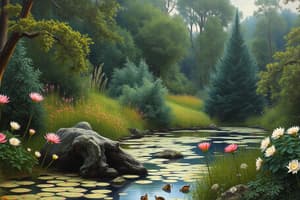Podcast
Questions and Answers
What is the primary method by which plants produce energy?
What is the primary method by which plants produce energy?
- Transporting water through stems
- Cellular respiration
- Photosynthesis (correct)
- Absorbing nutrients from the soil
Which part of a plant is responsible for absorbing water and nutrients from the soil?
Which part of a plant is responsible for absorbing water and nutrients from the soil?
- Stems
- Flowers
- Roots (correct)
- Leaves
What is the main function of leaves in plants?
What is the main function of leaves in plants?
- Transporting water and nutrients
- Conducting photosynthesis (correct)
- Anchoring the plant in the soil
- Producing seeds
What is the primary mode of obtaining energy for animals?
What is the primary mode of obtaining energy for animals?
Which characteristic distinguishes animals from plants?
Which characteristic distinguishes animals from plants?
What is the main purpose of flowers in plants?
What is the main purpose of flowers in plants?
What is the role of animals in ecosystems?
What is the role of animals in ecosystems?
What do herbivores contribute to the ecosystem?
What do herbivores contribute to the ecosystem?
Why are pollinators like bees, birds, and bats essential for plants?
Why are pollinators like bees, birds, and bats essential for plants?
What is the main function of carnivores in an ecosystem?
What is the main function of carnivores in an ecosystem?
What do omnivores contribute to the ecosystem?
What do omnivores contribute to the ecosystem?
Which role do plants play in ecosystems?
Which role do plants play in ecosystems?
How do animals help adapt to their environment?
How do animals help adapt to their environment?
Which statement about herbivores is true?
Which statement about herbivores is true?
What is the importance of understanding plant and animal species in ecosystems?
What is the importance of understanding plant and animal species in ecosystems?
Why do animals reproduce?
Why do animals reproduce?
Study Notes
Science Class 4: Exploring Plants and Animals
Introduction to Plants
Plants are living organisms that are characterized by their ability to produce their own food through a process called photosynthesis. They are an essential part of the ecosystem and provide food, habitat, and other resources for various organisms. Key plant characteristics include:
-
Photosynthesis: Plants absorb sunlight, carbon dioxide, and water to produce energy-rich sugars and oxygen through photosynthesis.
-
Roots: The root system of a plant anchors it in the soil and absorbs water and nutrients.
-
Stems: The stem supports the plant, transports water and nutrients, and conducts food.
-
Leaves: Leaves are responsible for photosynthesis, which produces food for the plant.
-
Flowers: Flowers are reproductive organs that produce seeds and contribute to the plant's growth and reproduction.
Introduction to Animals
Animals are multicellular, eukaryotic organisms that are characterized by their ability to move voluntarily and respond to stimuli. They obtain their energy by consuming other organisms, either in the form of food or other organisms. Key animal characteristics include:
-
Cellular Organization: Animals are made up of cells, which are the basic units of life.
-
Movement: Animals can move voluntarily, unlike plants.
-
Response to Stimuli: Animals can respond to stimuli, such as temperature changes or light, which helps them adapt to their environment.
-
Reproduction: Animals reproduce to create new individuals, ensuring the continuation of their species.
Plants and Animals in Ecosystems
Plants and animals play crucial roles in ecosystems. Plants provide energy and nutrients for other organisms in the ecosystem, while animals help control pests, pollinate plants, and maintain a balance in the ecosystem. Some key interactions between plants and animals include:
-
Herbivores: Herbivores are animals that eat plants. They help control plant populations and contribute to the nutrient cycle in the ecosystem.
-
Carnivores: Carnivores are animals that eat other animals. They help control the populations of other species and maintain a balance in the ecosystem.
-
Omnivores: Omnivores are animals that eat both plants and other animals. They help control both plant and animal populations and maintain a balance in the ecosystem.
-
Pollinators: Bees, birds, bats, and other animals help pollinate plants, which is essential for their reproduction.
Conclusion
Plants and animals are essential components of the ecosystem, and understanding their characteristics and interactions is crucial for maintaining a healthy balance in the natural world. By learning about the various plant and animal species and their roles in the ecosystem, we can appreciate the complex web of life that surrounds us.
Studying That Suits You
Use AI to generate personalized quizzes and flashcards to suit your learning preferences.
Description
Learn about the characteristics and roles of plants and animals in the ecosystem, including photosynthesis, cellular organization, and interactions in the natural world.





